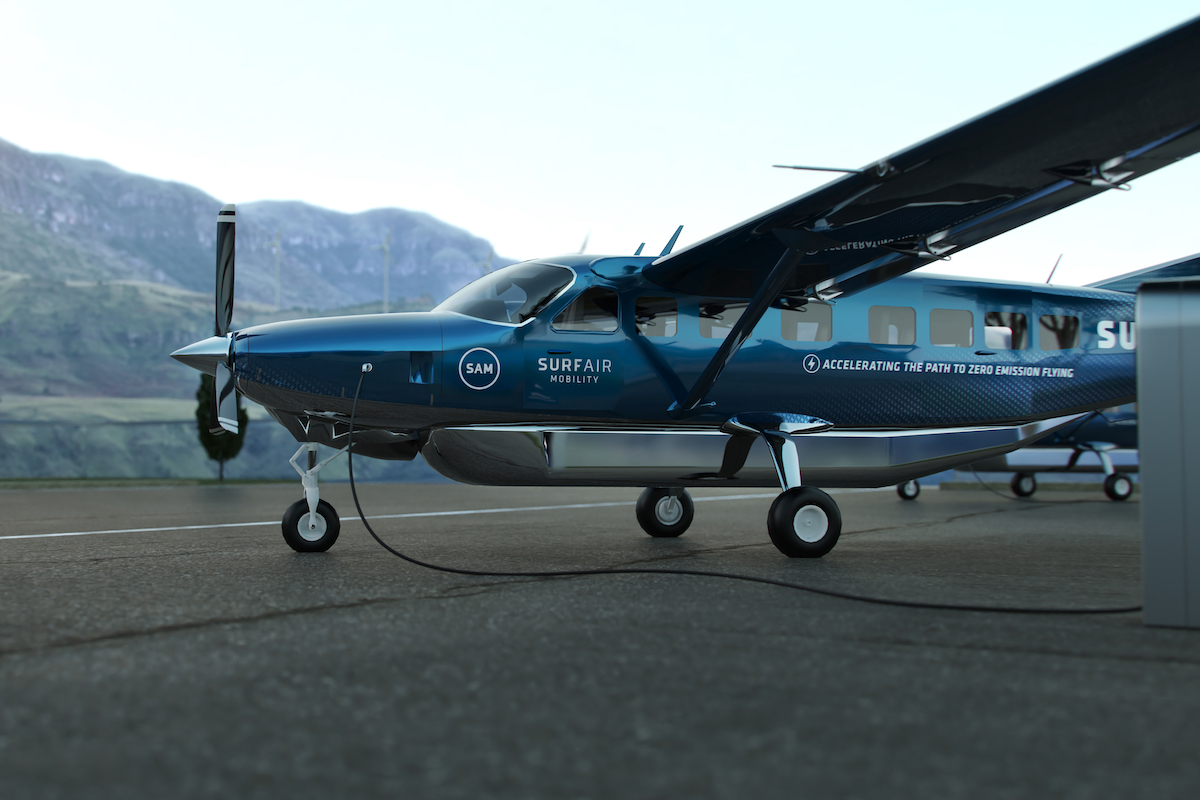Southern Airways Express, Surf Air Aim to Create First Electric Regional Airline

Photo Credit: Surf Air Mobility and Southern Airways Express are merging to accelerate the introduction of electric regional aircraft. Surf Air Mobility
Imagine hybrid electric aircraft ferrying travelers on hundreds of shorter routes across the U.S. That's the vision behind the planned merger of Southern Airways Express and Surf Air Mobility.
The deal, unveiled on May 18, will see the regional airline and electric aviation firm come together and go public under a $1.4 billion SPAC listing in the second half of the year. The deal is the first to bring together both sides of the equation — an airline and the technology developer — into one company amid the airline industry's rush to decarbonize air travel.
“It gives us what we need to be first out of the gate ... I want to be the first airline that puts paying passengers on a hybrid electric airplane," Southern Airways Express CEO Stan Little, and future president of the merged company, told Airline Weekly. The merger will provide Southern with the capital it needs for growth, including financing for the 100 Cessna Caravans on order from Textron that begin delivering at a rate of three per quarter from the fall.
For Surf Air, the deal provides the company the "best possible advertisement for its hybrid electric technology," said Little. The merger includes agreements with electric engine company AeroTEC and electric propulsion developer MagniX for hybrid electric powertrains that would power Southern's Caravans.
“We believe this sets us on a better, faster, and more certain path toward the future of green flying," Surf Air CEO Sudhin Shahani and other executives said in a May 18 letter to staff on the merger.
Electric aviation has come to the fore since in the past two years. Major carriers, from AirAsia to United Airlines and Virgin Atlantic Airways, have made commitments for electric vertical takeoff and landing (eVTOL) aircraft as part of their decarbonization drives. However, these small aircraft are not expected to replace existing flights but instead allow airlines to compete for so-called "last mile," or how travelers get to and from major airports, trips. Electric propulsion systems on existing aircraft, like the Caravan, or green-sheet regional planes — generally viewed as having fewer than 50 seats — are seen as having a much greater potential to reduce emissions from current aviation activities.
Work is well underway on electric propulsion systems, which are the key to electric aircraft. AeroTEC and MagniX flew a Caravan with their prototype electric technology in 2020. Former MagniX CEO Roei Ganzarski said in March 2021 that he expected certification of electric engines on existing airframes to come first before any new-build aircraft due to the higher certification hurdles entirely new designs face. "Electric aviation will start in niches," he said pointing to the Caravan and de Havilland Beaver seaplane — aircraft that serve specific niches — that had prototypes of MagniX's propulsion technology.
The engine Surf Air is developing is not all electric. It includes both internal combustion and electric engines similar to the set up in a hybrid car. In 2019, Air Lease Corp. Executive Chairman Steven Udvar-Hazy said hybrid-electric technology that could augment traditional fossil fuel-powered engines was the likely first step towards fully electric aircraft.
Other electric regional aircraft developers include Eviation and Heart Aerospace. The former has a commitment from Cape Air for its nine-seat Alice, while the latter has commitments from Finnair and United for its 19-seat electric ES-19.
Little declined to comment on where Surf Air's hybrid electric engine technology stands in terms of development. However, he hopes to introduce it on revenue flights within two to three years — or in the 2024-25 timeframe.
"So much of that is dependent on the FAA," Little said. He added that the U.S. Federal Aviation Administration is moving on certification slower than he's "ever seen before."
Surf Air targets a 50 percent reduction in emissions, and a 25 percent cut in operating costs for the Caravan with its hybrid electric engines. These savings are expected to make the economics work for so-called thin routes, or ones with less demand, Little said. These are markets that have overwhelmingly been cut from U.S. airline networks in recent decades amid rising costs and pilot staffing challenges. The economics of hybrid electric aircraft has only improved as oil prices have remained elevated.
Southern has a successful track record of expanding through acquisitions. The airline has acquired five airlines in its nine-year history, the latest being Air Choice One in April, and plans a major expansion with applications in for most the 29 government-subsidized markets that SkyWest Airlines is exiting. The airline is also on the cusp of unveiling a new operation in the Marianas with new Tecnam P2012 Traveller prop aircraft. Southern has none of the issues with pilot staffing that its larger peers face. SkyWest owns an undisclosed stake in Southern.
Southern and Surf Air anticipate up to $467 million in net proceeds from their merger and public debut. Combined revenues for the year are forecast at roughly $100 million.
